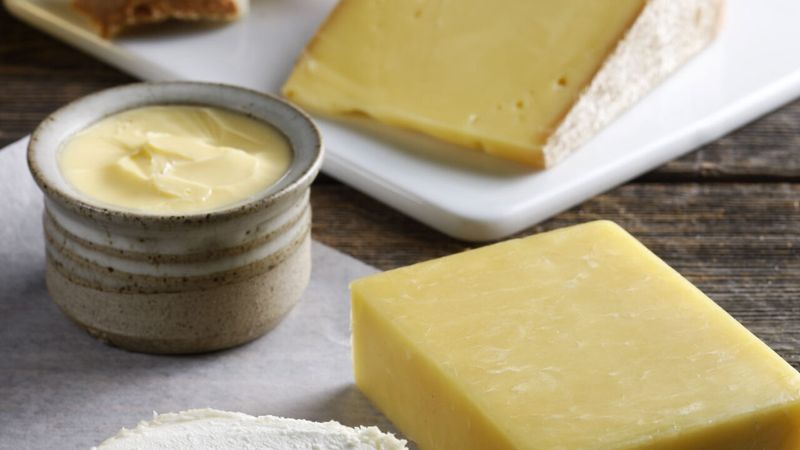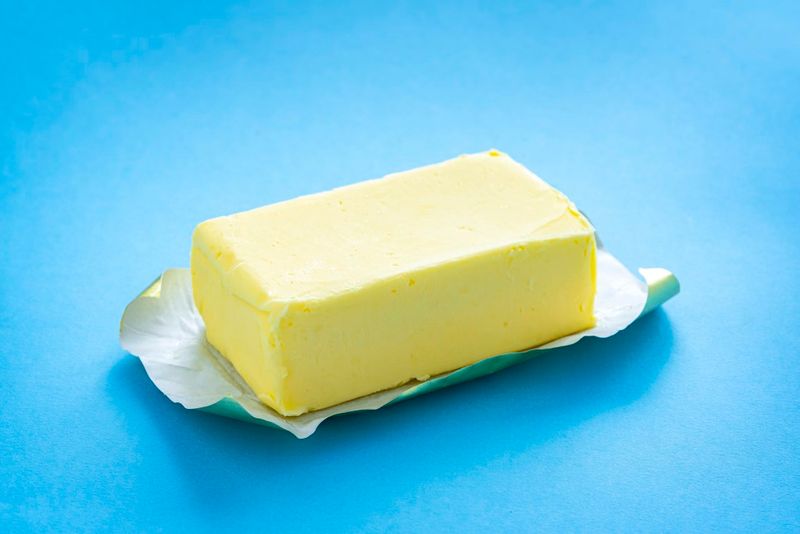Cholesterol is a waxy substance that’s found in many foods, and managing its levels is crucial for maintaining heart health. Some foods, surprisingly high in cholesterol, might be residing in your refrigerator, unsuspected. This article explores ten such foods, helping you become more aware of your dietary choices.
Cheddar Cheese

With its rich, creamy texture, cheddar cheese is a staple in many households. However, its high cholesterol content can surprise even the most health-conscious. Originating from the English village of Cheddar, this cheese is often aged to enhance its flavor. Despite its delicious taste, moderation is key. A single ounce contains about 30 milligrams of cholesterol, making it a food to consume sparingly. Pairing cheddar with whole-grain crackers or fruits can help balance its richness. Did you know? Cheddar can last longer when wrapped in parchment paper within the fridge.
Butter

Butter’s rich, luxurious flavor makes it a beloved ingredient in cooking and baking. Yet, its high cholesterol content may not be as beloved. One tablespoon contains about 31 milligrams of cholesterol. Though it enhances taste, using it in moderation is advisable. Switching to alternatives like olive oil can reduce cholesterol intake. Butter was once used in sacred ceremonies by ancient cultures, a testament to its historical value. While it adds flavor, balance is key to enjoying butter without guilt. The quest for a healthier lifestyle often starts with small changes.
Egg Yolks

Egg yolks are often hailed for their rich nutrients, yet they harbor high cholesterol levels. Each yolk contains about 186 milligrams. Balancing consumption by using more egg whites is a healthier choice. Eggs have been a breakfast staple for centuries, appreciated for their versatility. Historically, they symbolize new beginnings and fertility. While delicious, moderation is essential in maintaining heart health. Did you know? The color of an egg yolk can vary depending on a hen’s diet, adding a unique hue to your breakfast.
Liver

Liver, often dubbed as a superfood, is rich in nutrients yet high in cholesterol. A 3.5-ounce serving contains up to 564 milligrams, a significant amount. Its unique flavor is enjoyed in various cuisines worldwide. While nutritious, it’s wise to consume liver sparingly. Cooking methods like grilling can enhance its taste without adding extra fats. Historically, liver has been valued for its vitality-boosting properties. Its distinct taste and texture make it a culinary delight. However, keeping an eye on consumption can support a balanced diet.
Shellfish

Shellfish lovers might be surprised to learn about its cholesterol content. Shrimp and crab, popular choices, contain notable amounts. For instance, a 3-ounce serving of shrimp has about 166 milligrams. Despite this, shellfish are rich in omega-3 fatty acids, beneficial for heart health. Balancing intake with other protein sources is wise. Did you know? Shellfish have been part of human diets for thousands of years, considered a delicacy in many cultures. Their unique flavors and textures make them a gourmet’s delight, but moderation is key.
Sausage

Sausages bring a burst of flavor to meals but also carry a high cholesterol punch. A typical link can contain upwards of 76 milligrams. Known for their rich taste and versatility, sausages are enjoyed in breakfasts, BBQs, and more. However, opting for leaner meats or plant-based alternatives can help reduce cholesterol intake. Fascinatingly, sausages have been part of culinary history since ancient Rome. Their diverse range of flavors caters to many palates, yet managing portions is essential for heart health.
Bacon

Ah, bacon – synonymous with indulgence and flavor. Yet, it’s also synonymous with high cholesterol. Just three slices can have around 30 milligrams. Despite its crispy allure, bacon is best enjoyed occasionally. Trying turkey bacon offers a lower-cholesterol alternative. Bacon has historical roots, being loved by many cultures for centuries. Its unmistakable aroma and taste are hard to resist, but conscious consumption supports better health. Did you know? Bacon was once a breakfast luxury, reserved for special occasions rather than everyday fare.
Cream

Cream, whether poured into coffee or whipped atop desserts, adds richness. However, it’s also a source of cholesterol, with a tablespoon containing about 10 milligrams. Its luscious texture enhances culinary creations, but moderation is advised. Using lighter options like fat-free cream can reduce cholesterol intake. Historically, cream has been a symbol of luxury and indulgence. While it adds a velvety touch to dishes, balancing its use helps maintain a heart-friendly diet. Did you know? Cream was once a treasured ingredient in royal kitchens.
Processed Meats

Processed meats like salami and bologna, though convenient, carry high cholesterol levels. A single slice of salami can contain about 22 milligrams. Their savory taste fits well in sandwiches and snacks, yet considering alternatives is wise. The process of curing meats dates back centuries, offering preservation methods crucial for survival. They bring a taste of history to modern meals, but mindful choices ensure a healthier balance. Did you know? Some processed meats were once luxury items, reserved for festive occasions.
Ice Cream

Indulgent and delightful, ice cream is a treat loved by many. Yet, its high cholesterol content can surprise. A single cup contains about 29 milligrams. While tempting, enjoying smaller portions can keep cholesterol in check. With roots tracing back to ancient China, ice cream has been a cherished dessert for centuries. Its creamy texture and sweet taste make it irresistible. Did you know? In the past, ice cream was a rare luxury, often enjoyed by royalty. Today, embracing moderation helps savor its flavors responsibly.
Leave a comment